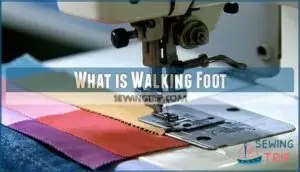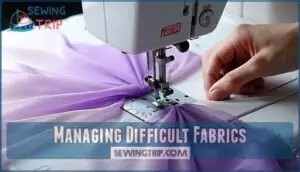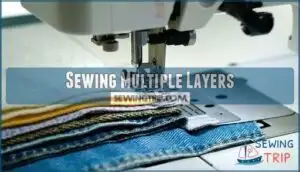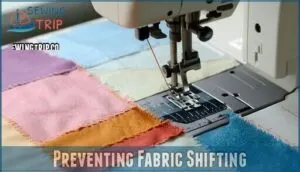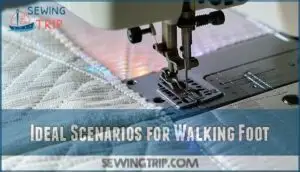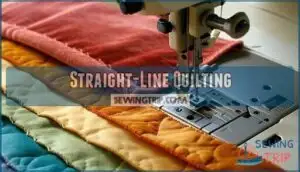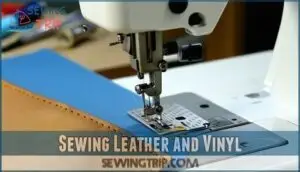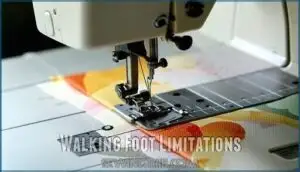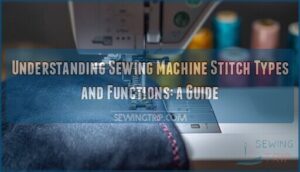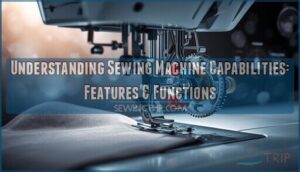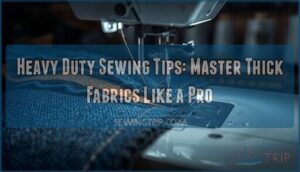This site is supported by our readers. We may earn a commission, at no cost to you, if you purchase through links.
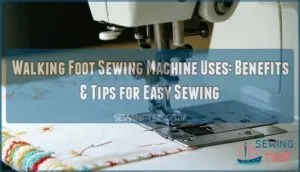
It’s perfect for sewing slippery fabrics, quilting thick layers, or even handling stretchy knits.
The walking foot moves both the top and bottom layers of fabric together, keeping everything aligned and avoiding that annoying bunching or shifting.
Think of it as your sewing assistant that guarantees smooth seams, no matter the challenge.
From quilting straight lines to stitching leather or vinyl, it’s a reliable tool for precision and control.
While it’s not for every stitch, it shines in the tough jobs.
Ready to explore more smart uses for it?
Table Of Contents
Key Takeaways
- You can use a walking foot to prevent fabric layers from shifting or puckering, especially when sewing thick seams, quilting, or working with slippery or stretchy materials.
- It feeds fabric evenly from both the top and bottom, making it perfect for tricky projects like quilting straight lines or sewing leather and vinyl.
- It’s not ideal for decorative stitches, reverse sewing, or speed, but it excels at precision and control, and tackling challenging fabrics.
- Using the right needle and thread is key for success, and setting up and maintaining the walking foot properly ensures smooth operation.
What is Walking Foot
A walking foot is a sewing machine attachment that helps feed fabric evenly while you sew, especially tricky or layered materials.
It works by gripping the fabric from both the top and bottom, making your stitches smooth and even.
Definition and Purpose
A walking foot, often called an even feed foot, helps your sewing machine handle fabrics more smoothly.
It works with the machine’s feed dogs, adding a dual feed system with top feed dogs for layer synchronization.
This prevents fabric shifting, making it essential for walking foot quilting and even feed sewing.
For example, it helps prevent fabric bunching during sewing.
It’s perfect for achieving smooth, even fabric feed on challenging projects.
Key Features and Benefits
A walking foot shines with its even fabric feed, using a unique fabric feeding mechanism to prevent fabric layers from shifting.
It improves control, delivers enhanced stitch quality, and prevents stretching on knits.
Ideal for even feed sewing or walking foot quilting, it reduces pinning, saving time and effort.
This dual feed sewing tool is a game-changer for tricky projects!
How It Works With Sewing Machines
A walking foot works by syncing with your sewing machine’s feed dogs to move fabric layers evenly.
Its unique fabric feeding mechanism uses a "lobster claw" that grips the fabric with precision.
- Attachment methods vary but are simple once you practice.
- It’s compatible with most machines.
- Dual feed systems guarantee even stitches without shifting or puckering.
Walking Foot Uses
You’ll find a walking foot handy for tackling tricky fabrics, sewing multiple layers, or keeping everything in place.
It’s a simple tool that solves common sewing problems like shifting, puckering, and uneven stitching, making it particularly useful for addressing issues with uneven stitching.
Managing Difficult Fabrics
Tackling slippery fabric, stretchy knit fabric, or thick seams can be tricky, but a walking foot makes fabric handling a breeze.
It grips fabric layers evenly, preventing puckering and misalignment, which is crucial for working with silky chiffon or precise pattern matching on tricky prints.
Whether working with knit control for stretchy garments or precise pattern matching on tricky prints, this sewing accessory keeps everything smooth and under control—like a sewing buddy.
Many find success using walking foot with knits.
Sewing Multiple Layers
Ever tried sewing fabric layers only to battle puckering or uneven seams? A walking foot makes it easy.
It guarantees fabric stability and layer alignment, even feeding top and bottom layers smoothly. Here’s how it helps:
- Tackles seam bulk on quilts.
- Prevents puckering on thick layers.
- Enhances fabric feeding for multi-layer projects.
- Keeps stitching flawless. Perfect solution!
Preventing Fabric Shifting
A walking foot helps keep things steady, especially when tackling shifting fabrics during sewing.
Its even feeding system guarantees top and bottom layers stay aligned, preventing puckering and mismatched seams.
No more battling slippery materials or stubborn corners—seam precision is yours.
| Problem | Solution with Walking Foot |
|---|---|
| Fabric shifting | Even feeding guarantees alignment |
| Puckering on seams | Smooth fabric feeding operation |
| Slippery fabrics | Stabilized fabric movement |
| Thicker layers bunching | Top and bottom feeding grips |
| Mismatched patterns | Perfect layer synchronization |
Ideal Scenarios for Walking Foot
You’ll find a walking foot most helpful when sewing tricky materials like knits, slippery fabrics, or bulky seams.
It keeps everything moving evenly, so you don’t end up with stretched hems or mismatched layers, which makes it a crucial tool for achieving professional-looking results with tricky materials.
Quilting and Sewing Knits
When quilting or working with knit fabric, a walking foot is your best friend.
It keeps fabric layers from shifting during machine quilting and guarantees smooth quilt binding.
Say goodbye to stretched knit stitching and misaligned patterns.
Whether you’re crafting quilts or handling delicate knits, this tool guarantees perfect pattern matching and consistent stitching every time.
Many sewers find success with specific quilting products, which can greatly aid in achieving consistent stitching.
Handling Bulky Seams
Bulky seams can feel like wrestling a bear, but an even feed foot turns your sewing machine into an ally.
Seam thickness and uneven layers? No problem.
The walking foot handles multiple layers with an even feed, stopping fabric creep in its tracks.
Adjust stitch length and needle choice for smoother stitching and let the walking foot do the heavy lifting.
Sewing Slippery Materials
Thick seams can be tricky, but slippery fabrics bring their own battle.
A walking foot on your sewing machine stops slippery fabric from slipping and saves your sanity.
Its dual feed foot keeps fabric alignment perfect, preventing slippage.
Match your needle type and thread tension for smooth sewing.
Knowing that neoprene lacks a right side can also simplify the sewing process.
With proper sewing machine feet, stitch quality will amaze you!
Walking Foot Applications
You’ll find a walking foot especially handy for tasks like straight-line quilting and sewing tricky materials such as leather or vinyl.
It guarantees your fabric layers stay put, giving you smoother stitches and fewer headaches.
Straight-Line Quilting
A walking foot makes straight-line quilting a breeze.
It feeds fabric layers evenly, preventing puckering and shifting, which keeps your straight lines smooth.
Whether you’re stitching rows, grids, or unique patterns, the walking foot guarantees even stitching across your quilt.
Many quilters find specialty feet beneficial for advanced techniques.
It’s your secret to hassle-free machine quilting with professional-looking results on tricky materials like velvet or corduroy.
Sewing Leather and Vinyl
Leather and vinyl can be tricky, but a walking foot simplifies things by feeding all layers evenly.
Use a leather sewing machine or heavy-duty sewing setup, adjust stitch length and tension carefully, and reduce foot pressure for smooth results.
Seam finishes matter here—backstitching isn’t ideal.
For thick materials, the walking foot guarantees precision and prevents puckering.
For better results, consider using longer stitch lengths to achieve a professional finish with smooth results.
Walking Foot Limitations
While a walking foot is incredibly useful for many sewing tasks, it’s not perfect for everything.
You might find it tricky to use with decorative stitches, curves, or faster sewing speeds.
Incompatible Stitch Types
The walking foot isn’t built for reverse sewing, free-motion quilting, or side-motion stitching.
Its feed dogs move fabric forward, making complex curves or decorative stitches tricky, and using incompatible stitch types can result in bunching or uneven feeding.
Stick to simpler, forward-feeding patterns to avoid frustration, as your sewing machine will excel at what the walking foot does best—precision and control, with care.
Speed and Precision Limitations
Though a walking foot excels with tricky fabrics, it’s not built for speed or fine details.
Sewing machine speed maxes out slower, so intricate designs need patience.
Reverse stitching and decorative stitches? Forget about it.
Precision drops on curves too.
But for fabric alignment and even feeding, it’s worth the trade-off.
For example, it’s useful when doing stitch-in-the-ditch quilting.
Go slow, nail consistency!
Setup and Adjustment Requirements
Getting your walking foot working smoothly takes a little effort.
Be mindful of how it fits your sewing machine setup, as improper pressure settings or tension balance can cause issues. Check alignment with feed dogs and adjust stitch length for thick fabrics.
- Foot Attachment: Secure it firmly and align it correctly.
- Pressure Settings: Adjust for fabric thickness.
- Tension Balance: Test stitches for consistency.
Frequently Asked Questions (FAQs)
Why would you use a walking foot?
You’d use a walking foot to keep fabric layers from shifting or puckering while sewing.
It’s perfect for thick seams, slippery fabrics, quilting, or matching patterns.
Think of it as fabric teamwork simplified!
Can a walking foot replace a regular presser foot?
Think of a walking foot as a trusty sidekick, not a full replacement.
While it’s perfect for tricky fabrics and layers, you’ll still need your regular presser foot for curves, backstitching, and decorative stitches, as a walking foot is ideal in specific situations.
How is a walking foot maintained or cleaned?
Keep your walking foot clean by wiping it with a soft, lint-free cloth after each use.
Remove built-up lint or threads with a small brush.
Occasionally, check for loose screws, and tighten them if needed.
Does a walking foot require specific needle types?
A walking foot doesn’t need special needles, but using the right needle for your fabric is key.
For thick fabrics, try heavy-duty needles; for delicate materials, stick with finer ones to avoid snags.
What thread types work best with a walking foot?
Polyester and all-purpose threads work great, as they’re strong and smooth, reducing breakage and tangling.
Heavy-duty threads suit thick fabrics, while finer threads handle delicate ones.
Match thread type to your fabric for best results!
Are there alternatives to a walking foot for similar tasks?
Picture a steady dance partner—alternatives like a presser foot with Teflon coating, roller feet, or built-in dual feed systems can tackle slippery fabrics, thick layers, and challenging projects.
Adding smooth movement without the price tag.
Conclusion
Don’t discount the dynamic differences a walking foot sewing machine can make!
It’s a lifesaver for managing tricky fabrics, sewing multiple layers, and achieving smooth, professional seams with ease.
Whether you’re stitching slippery satin, quilting thick layers, or tackling tough leather, the walking foot guarantees precision and control.
While it’s not for all stitches, its benefits are undeniable for tough jobs, and you’ll wonder how you ever sewed without it, exploring its potential.

